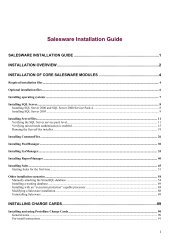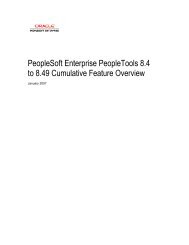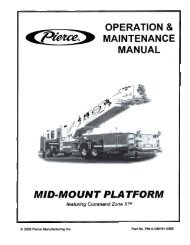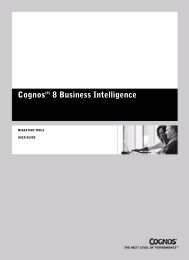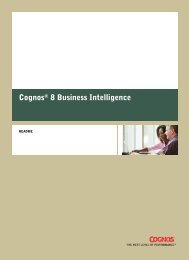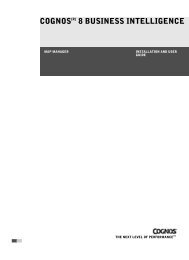COGNOS Business Intelligence Series 7
pes.pdf
pes.pdf
Create successful ePaper yourself
Turn your PDF publications into a flip-book with our unique Google optimized e-Paper software.
Chapter 3: Control Processes<br />
You control the processing resources allocated to a cube or report by adjusting the Process<br />
Control settings, particularly Minimum Processes and Maximum Processes.<br />
Minimum Processes<br />
Minimum processes are the number of processes that remain running after they open. Keeping<br />
processes open improves performance, particularly with cubes and reports that are hit frequently.<br />
Maximum Processes<br />
When a cube or report starts receiving more requests than available processes can handle,<br />
PowerPlay Enterprise Server opens additional processes, up to the number you have defined as the<br />
maximum for the cube or report. If the maximum is reached, the dispatcher starts queuing<br />
requests until processes become available. By default, a queued request is deleted after 15 seconds.<br />
By setting minimum and maximum processes, you can control the number of processes that occur<br />
on each dispatcher. The number of processes does not have to reach its maximum value before<br />
additional processes can be sent to a different dispatcher. When the number of hits on the cube or<br />
report exceeds the Maximum Processes threshold, instead of queuing up requests, they are<br />
forwarded to the mirror reference, which is free to immediately process more requests.<br />
If you have a dispatcher that you want to act only as a router, that is, to only pass requests, you<br />
can set the Maximum Processes value for that dispatcher to 0. Then, all of the processing will take<br />
place at an available mirror location and no processing will take place on the dispatcher. You can<br />
even set the Maximum Processes value for individual cubes.<br />
Example 1: Dedicated Processors<br />
In the configuration depicted below, each of four cubes has a dedicated computer on which to<br />
process requests.<br />
These cubes are configured with no source and a single mirror reference. On the computers that<br />
process the cubes, each cube is configured with a source and must have sharing enabled.<br />
Example 2: A 7 x 24 System<br />
In the configuration depicted below, a report has three computers that can handle overflow. If the<br />
report processor is very busy, any of the supporting computers can pick up the request, relieving<br />
the first computer from having to queue reports. This effectively triples the number of available<br />
processes for the report without requiring you to increase the Maximum Processes limit to a level<br />
that the first computer may not be able to handle. This configuration is also useful in a 7 x 24<br />
system that offers redundancy to minimize any single point of failure.<br />
The report is configured with a source on the same computer and three mirror references.<br />
30 Cognos PowerPlay (R)




